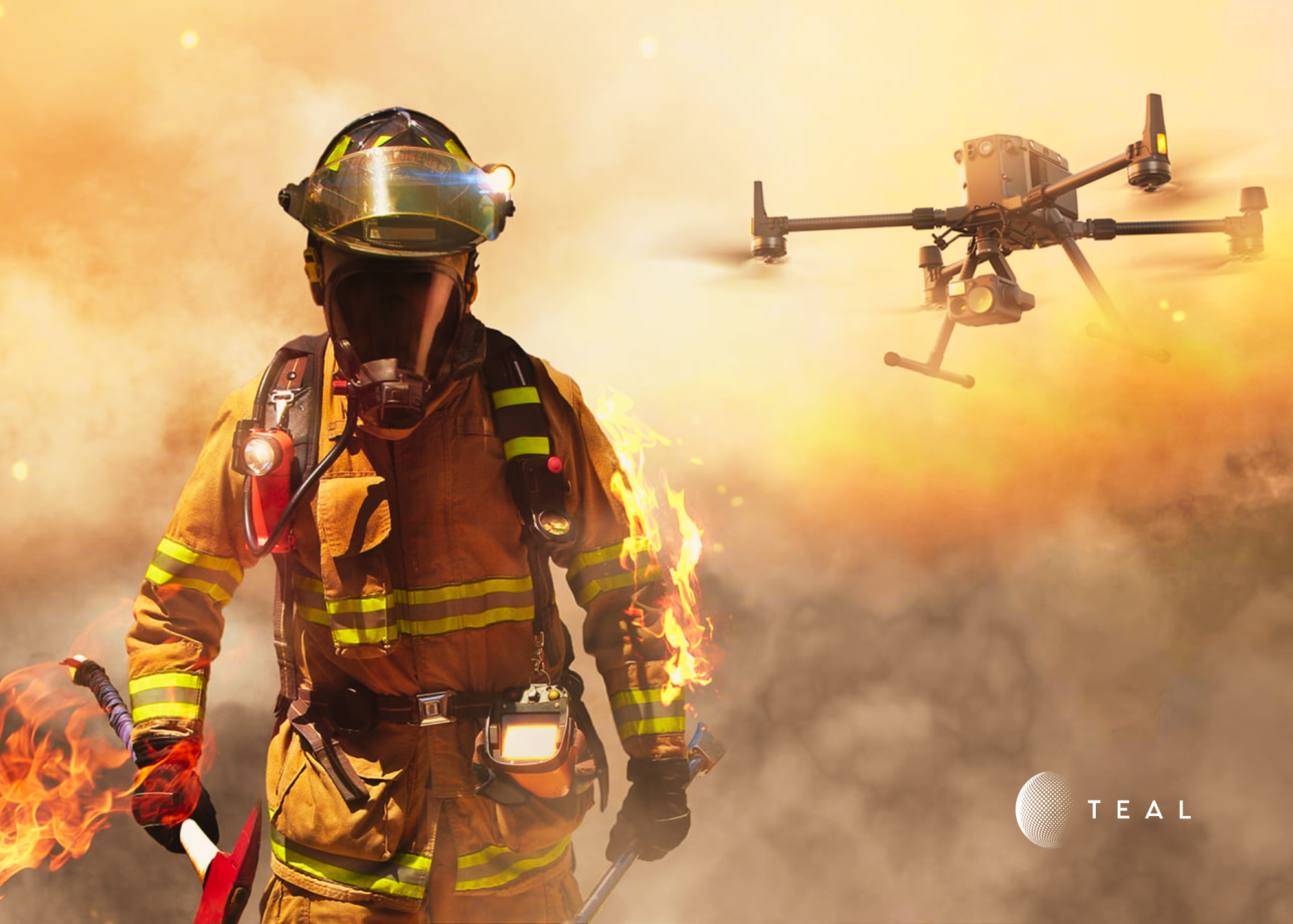The Future of Aerial Firefighting Technology: Enhancing Emergency Response with Drones

Disclaimer: The use of private drones can interfere with firefighting efforts and should be strictly prohibited. This article aims to highlight Drone as First Responder solutions that are authorized and used by emergency responders. Private drones can disturb existing aerial firefighting efforts and the use of UAVs during emergencies should be restricted to public safety agencies that have been approved to utilize drones as part of their response efforts.
Imagine battling intense flames through smoke and heat, with only seconds to make potentially life-saving decisions. For firefighters and emergency responders, this is a daily reality. However, thanks to the integration of cutting-edge drone technology, the approach to firefighting and emergency response is undergoing a major transformation.
Drones, or unmanned aerial vehicles (UAVs), are enhancing efficiency, safety, and decision-making in firefighting operations worldwide. From providing real-time data to reducing human exposure to dangerous conditions, drones are quickly proving themselves indispensable to modern firefighting efforts.
How Drones are Being Used for Firefighting
1. Real-Time Aerial Surveillance for Situational Awareness
Fires doesn’t wait to spread, and neither should firefighting strategies. With drones, incident commanders gain access to real-time aerial views of fire-impacted areas. This empowers them to assess the fire’s size, spread, and behavior more effectively.
Equipped with high-resolution cameras and live-streaming capabilities, drones capture dynamic visuals of fast-moving blazes. With this unparalleled situational awareness, responders can coordinate emergency action plans, adjust strategies, and direct resources to where they’re needed most—all while keeping teams safe. Thermal imaging technology further enhances this capability, enabling firefighters to see through dense smoke and pinpoint hotspots or trapped individuals.
2. Thermal Imaging for Hotspot Detection and Search & Rescue
Specialized firefighting drones with thermal cameras are capable of detecting heat signatures, even in low-visibility conditions. For buildings, this means locating structural hotspots before venting, reducing the risk of backdrafts.
But thermal drones aren’t just for fire suppression; they also play a critical role in search and rescue (SAR). Whether in remote forests or smoke-filled urban environments, these drones can identify trapped individuals or missing persons, allowing rescue teams to prioritize efforts and minimize loss of life.
3. Predicting and Mitigating Wildfires
Wildfires are notoriously unpredictable, and early action is key to containment. Drones equipped with advanced sensors and Artificial Intelligence (AI) platforms are advancing fire prediction and detection.
- Drones like those used by forest services collect atmospheric data, such as wind speeds and temperature changes. Such information feeds models like NASA’s fire spread prediction system or the University of Montana’s wildfire forecast tools.
- Other applications, such as Paso Robles Fire Department’s thermal-equipped drones, quickly scan vast areas like the Salinas Riverbed to detect potential fire threats—areas that would be impossible to monitor as easily on foot.
By identifying risks before disaster strikes, firefighters can curb wildfires before they escalate.
4. Post-Fire Assessment and Recovery
Once the flames are extinguished, the work of analyzing the damage and beginning recovery begins. Drones offer detailed aerial surveys of impacted areas, creating high-resolution maps and 3D models to evaluate structural, environmental, and infrastructural damage.
This data is vital not just for insurance claims but also for post-fire investigations and restoration planning. By using drones, emergency teams save time and resources while ensuring a comprehensive view of the damage.
5. Delivering Critical Equipment to Hard-to-Reach Areas
Imagine a remote wildfire enclosure in mountainous terrain or a blazing urban high-rise where firefighters struggle to carry heavy equipment. Drones provide a solution, delivering essential firefighting supplies such as hoses, water pumps, and even medical assistance kits to otherwise inaccessible locations.
This capability significantly accelerates response times and ensures that critical resources reach those in immediate need.
6. Improving Communication and Coordination
During disasters, reliable communication is crucial, but conventional infrastructure often fails. Drones equipped with communication devices act as airborne relays, connecting agencies and teams no matter the conditions on the ground.
This seamless communication enhances collaboration among responders and ensures that vital information flows efficiently between the field and command centers.
Why Choose Drones for Firefighting?

Efficiency and Cost-Effectiveness
Public safety drones offer significant operational advantages over traditional surveillance tools like helicopters. Drones can be swiftly deployed, provide live visual data, and operate around the clock—all without excessive manpower or costs.
Fewer personnel are needed on the scene thanks to drones’ reach, enabling remote monitoring that supports strategic firefighting efforts while preserving resources.
Enhanced Safety for Firefighters
One of the most vital benefits of drones is how they protect the people who dedicate their lives to saving others. By gathering essential data from firegrounds before responders enter, drones drastically reduce firefighters’ exposure to dangerous situations, including unpredictable fire behavior and collapsing structures.
From urban fire incidents to sprawling wildfires, drones enhance situational awareness, improving both the safety and efficiency of operations.
A Game-Changer for Wildfire Management
For vast forest fires, drones offer an unmatched advantage. With the ability to fly through dense smoke and treetops, drones deliver critical intelligence to incident commanders. This allows teams to build better containment plans and avoid situations where teams might be surrounded by fire.
High-Tech Firefighters in Action
Leading American-made drones like Skydio are designed specifically to handle emergency scenarios with precision. These drones offer in-depth situational awareness, using thermal imaging and real-time data streaming to help fire teams coordinate quickly and effectively.
Another notable player is BRINC, which integrates drones with CAD systems and Live911 software for rapid deployment. The result? Eyes on the scene within 70 seconds of a call, revolutionizing emergency response.
American innovation doesn’t stop there. Companies like Robotics88 construct drones exclusively for wildfire management, while TEAL’s eSIM technology ensures reliable network connectivity, allowing seamless communication and control no matter the location.
The Future of Firefighting Starts with Drones
The adoption of drones as first responders represents a profound shift in firefighting. Their ability to deliver live visuals, enhance safety, and improve efficiency makes them invaluable tools for fire departments.
Data provided by drones helps firefighters make better decisions about resource allocation, evacuation, and firefighting strategies. But maximizing their potential requires reliable cellular connectivity. Consistent cellular performance ensures drones perform optimally and respond without delays, even in the most remote locations.
The Need for Mission Critical Connectivity – Don’t Let Spotty Cell Service Doom Your Drones
For DFR programs to succeed, redundant cellular connectivity is paramount. Beyond Visual Line of Sight (BVLOS) drone operations require real-time, low-latency data transfer for safe and responsive missions. TEAL’s eSIM technology outperforms traditional roaming services, ensuring higher reliability and faster deployment times. This connectivity is crucial for maintaining continuous GNSS positioning and adhering to FAA regulations, which mandate protocols for lost connections to ensure safety.
Relying on cell service for your agency’s drone operations is fine until there’s unreliable cell service. And there are many parts of America, both rural and near major metropolitan areas, where cell service is spotty at best. Some DFR solutions like BRINC offer the ability to pair cell and radio systems together with their BRINC Connect blended communication system to get the benefits of each while adding redundancy and flexibility.
The FAA’s rules for Beyond Visual Line of Sight (BVLOS) drone operations include specific protocols for when a drone loses connection. If a drone loses its connection, it typically must have a “return to home” (RTH) feature that automatically navigates it back to its base or a pre-determined safe location. This is to ensure safety and minimize risks associated with losing control of the drone.
Additionally, the FAA requires that BVLOS operations maintain reliable GNSS positioning to ensure continuous tracking and control. These measures are part of the broader regulatory framework aimed at ensuring the safety and reliability of BVLOS drone operations and highlight the importance of redundance cellular connectivity.
With TEAL, mission-critical drones benefit from over-the-air access to connect onto any network globally.
Be Part of the New Era of Emergency Response
As drones become more affordable, accessible, and capable, their role in public safety will only continue to expand. By taking advantage of innovative tools like drones, agencies can ensure safer, more efficient operations and pave the way for a technologically advanced future.
Ready to learn more about how mission critical connectivity from TEAL can ensure that your drones are always connected and always operational? Schedule a call today to learn more!
Click Here to Book a Meeting
Recent Posts
CES 2026: The Connected Future, Through TEAL’s Lens
Teal Communications Staff2025-12-18T18:58:56+00:00
The Fastest Growing Company in the PNW isn’t an AI Startup… it’s TEAL
Teal Communications Staff2025-12-10T20:43:23+00:00
The Sky is the New Cell Tower: Satellites Are Reshaping the MNO Landscape
Teal Communications Staff2025-12-09T21:28:24+00:00




